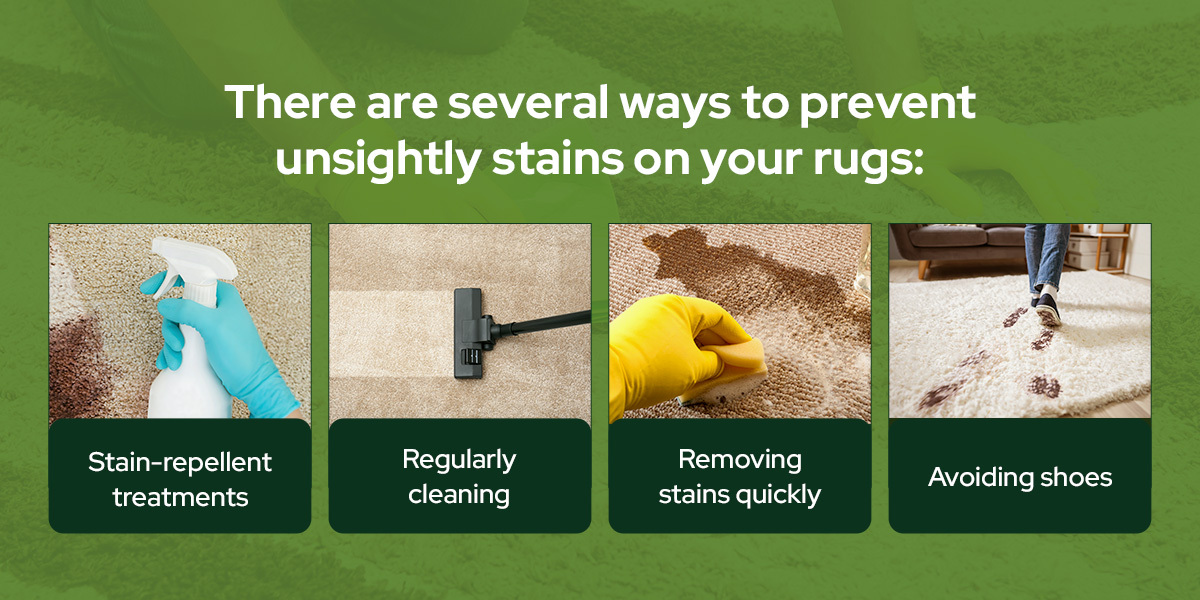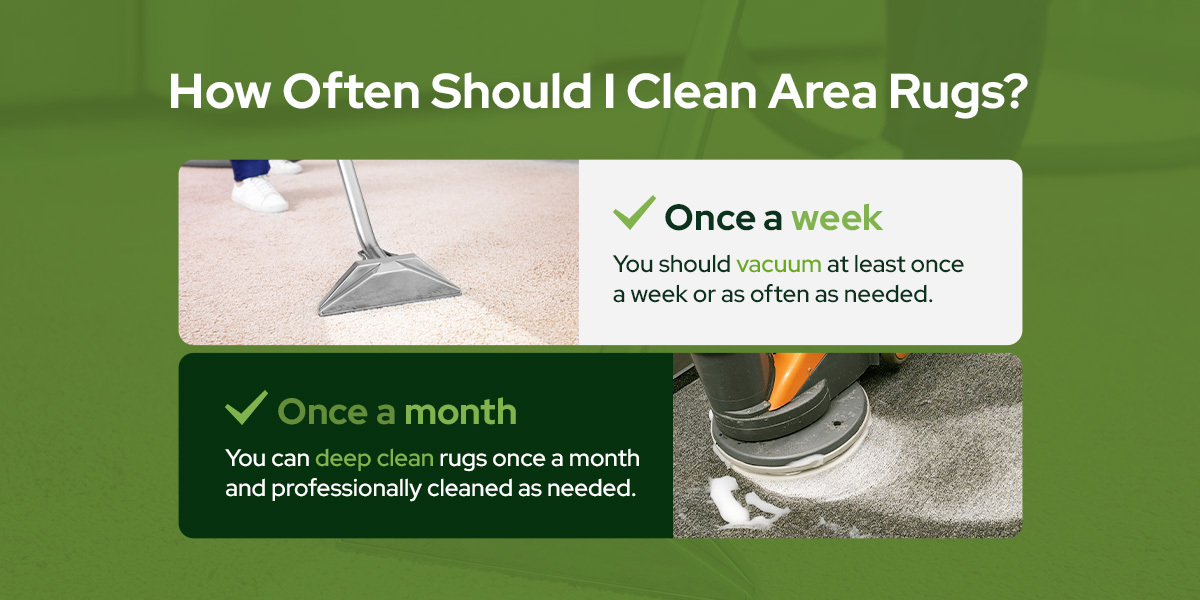AREA RUG CARE GUIDE
Why is proper care and maintenance important?
An area rug is a beautiful way to bring a room together while adding comfort and warmth. Understanding area rug care and cleaning is vital for maintaining these benefits and your rug's longevity.
Ways to Care For and Maintain Rugs
By incorporating these key elements, you can properly maintain your area rug and keep it in good condition:
Padding
Using a rug pad is an excellent way to care for your area rug and your floors. Padding provides cushioning between the floor and the rug and offers numerous benefits:
- Keeps rugs from curling up and slipping underfoot.
- Protects the rug's edges and reduces unfurling.
- Guards the floor from scuffs and scratches.
- Adds extra insulation.
- Provides extra softness and comfort.
- Prolongs wear by absorbing shock, thus protecting the rug fibers.
Vacuuming
Vacuuming is an essential part of rug care. Doing so weekly lets you remove surface-level dirt that can damage your
rug's fibers, affect its appearance and even trigger allergies.
Ensure you vacuum the rug in the direction of the pile, preferably with a canister vacuum without beater bars and with rug-cleaning attachments. A good practice is to avoid running vacuums over edges and fringes repeatedly as this can damage them. Don't forget to vacuum reversible rugs on both sides to prevent buildup of dirt on one side. It is also important to note that certain rugs like heavy shags cannot be vacuumed. Rather take these outside and shake them loose to remove dirt.
Rotate and Flip the Rug
One of the best ways to prevent wear on your rug is by rotating it semi-annually. Rotating and flipping keeps the rug looking even all the way around as the wear from high traffic is more evenly distributed.
Cleaning
Regular cleaning is the foundation of caring for your rug. Weekly routines are essential, but deep cleaning and spot cleaning are just as vital. Deep cleaning — which is typically done by professional carpet cleaners — uses specialized equipment, top-quality cleaning agents, and the correct techniques and expertise to restore your rug's appearance.
Spot cleaning is a simple way to maintain your rug's appearance when you do not necessarily have the time to do a full rug clean.
Tips for Cleaning Each Rug Type
Each rug has its own cleaning requirements, depending on the type of material:
Synthetic Fibers
Apply these tips for cleaning different synthetic fibers:
Acrylic
Use a common cleaning detergent or create one with a teaspoon of neutral detergent and a teaspoon of pure white vinegar combined with a quart of warm water. Absorb as much of the stain as possible before applying the cleaning solution.
Polypropylene
Polypropylene is one of the most stain resistant fibers as it resists moisture damage very well. Follow wool cleaning instructions to care for polypropylene.
Viscose
You can maintain a viscose rug by placing it away from high traffic areas — such as in a main bedroom — as it does not take moisture and heavy foot traffic well. Professionally clean or use a spot cleaner with very little moisture.
Polyester
Polyesters, like polypropylene, is one of the most stain resistant fibers as it resists moisture damage very well. Follow wool cleaning instructions to maintain polyester.
Natural Fibers
Care for your rug's natural fibers with these tips:
Cotton
You can machine-wash small cotton rugs using warm water and a mild detergent. Treat larger cotton rugs with a dry cleaning powder to protect the fibers.
Sisal
Use a dry cloth to blot the stain, then use water and pure vinegar together to treat the stain. Be sure to wring out the cloth prior to applying the solution, as excessive moisture is not healthy for sisal rugs.
Jute
To properly care for jute rugs, limit the amount of moisture used when treating a stain and never steam clean. Treat stains by dabbing a small amount of club soda or a cloth dampened with mild soap.
Wool
Use a specially made wool detergent or create one with a teaspoon of neutral cleaning detergent mixed into a solution of white vinegar and 4 cups of warm water. Absorb as much of the stain as possible before applying the cleaning solution.
Common Rug Issues & How To Avoid Them
Area rugs can encounter various issues over time especially with an active household, but with proactive measures many of these issues can be avoided or mitigated. Here are some common area rug issues and tips on how to prevent them and promote a happy healthy home:
Stains
There are several ways to prevent unsightly stains on your rugs:
- Stain-repellent treatments: A great defense against stains is opting for rugs that are treated with a stain-repellent coating. There are also various stain-repellent treatments available that you can apply to protect the fibers.
- Regularly cleaning: Weekly vacuums and a quarterly deep clean can help lift stains and maintain your rug's appearance. Regularly professional cleanings are also highly beneficial for treating rugs and removing tough stains.
- Removing stains quickly: If an accident happens, acting quickly before the substance has set is the key to preventing a stain. Dab the spot immediately, then apply a rug cleaner. Be careful not to scrub the spill deeper into the fibers.
- Avoiding shoes: One of the most simple but effective ways to protect your rugs from stains is to have a “no shoes” policy. Wearing outdoor shoes indoors can track in dirt, dander, mud and even moisture.

Color
Colors can vary slightly between rug dye lots and is more common in handmade rugs than in machine-made or power-woven rugs. This occurrence can be minimized by ordering multiple rugs at the same time.
Creasing
Creasing can happen as a result of your rug being folded during shipping. You can usually fix it by laying your carpet flat in the sun for an hour or two. You could also vacuum, blow dry or lightly steam the rug to help speed along the process.
Odor
Your rug may have a slight odor from being shipped in a tightly sealed bag. Thankfully, the odor naturally clears after removing your rug from the bag. If your existing rug has started to smell, even after regular vacuuming, it's time for a professional deep clean.
Wear and Tear and Fading
Rugs are naturally subjected to wear and tear, especially in areas with heavy foot traffic. If your area rug is in a room that receives a lot of direct sunlight, it may start to fade over time. Maintaining your rug by flipping and rotating it every six months minimizes fading and wear and tear.
Mold & Mildew
Prevent moisture buildup by ensuring rugs are not placed over damp surfaces or in areas with poor ventilation. Clean up spills promptly and allow rugs to dry thoroughly if they become wet. Use a dehumidifier in humid climates or during wet seasons to reduce moisture levels in the air.
Shedding
It is completely normal for new area rugs to shed loose fibers. Shedding is a part of the wearing-in process. It naturally minimizes over time, and vacuuming can help speed the process along. Some rugs are prone to shed more than others as it depends on the construction of the rug and the quality of the materials its made from.
Sprouts
Sprouts are long, loose fibers that may appear on your rug's surface. These should never be pulled and should only be trimmed carefully with sharp scissors even with the pile of the rug. This is a common characteristic of an area rug and is not considered defective or damaged.
Step-by-Step Guide to Cleaning a Rug
Here's how to clean an area rug in a few easy steps:
- Clear surrounding furniture and any objects sitting on the rug.
- Vacuum the rug to remove all surface-level dirt and dust.
- If possible, take your rug outside for the rest of the cleaning and drying.
- Use a rug shampoo and follow the directions to mix the solution with water. Do not use carpet cleaner for your rug — those detergents may be too strong and ruin your rug's fibers.
- Perform a color test on a small area in the corner of your rug to ensure the shampoo does not cause color bleeding.
- Use a soft-bristled brush or sponge to lather the cleaner into your rug.
- Allow the cleaning solution to sit for a couple of minutes or as directed before thoroughly rinsing with clean water.
- Use a wet-dry vacuum to remove excessive water from the rug.
- Allow the rug to dry completely outside before bringing it back inside.
Frequently Asked Questions
Transform how you clean your area rugs by exploring the answers to these frequently asked questions:
What Tools and Supplies Do I Need to Clean an Area Rug at Home?
How you clean your rug depends on the rug type and how dirty it is. A few basic tools to keep on hand include:
- A wet-dry vacuum
- Rug shampoo
- A sponge or soft-bristled brush
- A bucket
- A garden hose
- Rubber gloves
How Often Should I Clean Area Rugs?
How often you should clean your rugs depends on the type of cleaning you are doing. You should vacuum at least once a week or as often as needed, and rotate the rug every couple of months to maintain its appearance. You can deep clean rugs once a month and have them professionally cleaned as needed.

Can You Clean Area Rugs with a Pressure Washer?
It is generally suitable to use a pressure cleaner for washable rugs made of synthetic materials like polyester and polypropylene. Use the lowest PSI to protect the rug and maintain its structure. Pressure cleaning is not suitable for natural materials like jute and wool, and you should take great care when deep cleaning rugs made from natural materials to avoid damaging the delicate fibers.
Do Steam Cleaners Work on Area Rugs?
It depends on the rug. Steam cleaning penetrates deep within the rug to loosen dirt that you remove with your vacuum. Steam cleaning can also kill dust mites, making it an effective way to sanitize.
It is vital that you follow manufacturer guidelines for steam cleaning your rug, and proceed with caution when cleaning natural fibers. Avoid steam cleaning valuable antique rugs and take them to a professional with experience treating delicate fibers.
How Long Does It Take for an Area Rug to Dry After Steam Cleaning?
Depending on the rug's material and weather conditions, it may take up to 12 hours for your rug to dry completely. You can shorten this time by vacuuming out excessive water after rinsing, allowing the rug to dry outside in optimal conditions and turning a fan on once the rug is back indoors.
Shop Rugs for Your Home from Carpet & Tile Mart
Having a clean area rug elevates your space and maintains the rug's integrity. If you are looking for a beautiful new area rug to add to your home, Carpet & Tile Mart has the flooring solution for you! Our flooring supercenters house a range of quality rugs, carpets, tiles and hardwood products.
We prioritize convenience, value and customer service and make it simple to find the best rugs at competitive prices. Browse our rugs and other flooring products today!

Questions & Concerns?
If you have any additional questions or concerns not answered here you can always reach out for more information on your specific situation.





